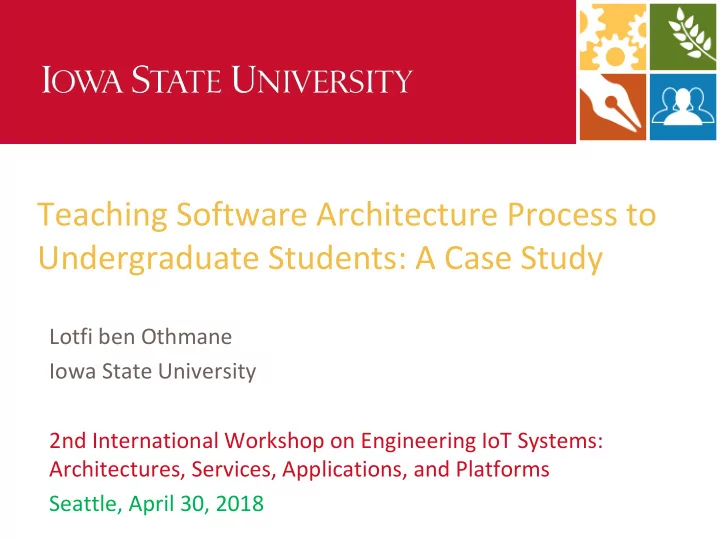

Teaching Software Architecture Process to Undergraduate Students: A Case Study Lotfi ben Othmane Iowa State University 2nd International Workshop on Engineering IoT Systems: Architectures, Services, Applications, and Platforms Seattle, April 30, 2018
Challenges of Teaching Software Architecture Characteristics of the learners Characteristics of software (Undergrad) architecture: • Requires strong • Have limited knowledge experience and experience • Used to concrete • Fuzzy - deals with unclear problems and concepts, precise solutions problems and solutions • Use simple applications • Applies to complex software 2
Classic Program - A Set of Topics Overview of software architecture: what? And why? 1. Software architecture structure and styles 2. Software quality attributes 3. Overview of software engineering principles 4. Introduction to design by contract 5. Introduction to UML 6. Software reengineering 7. Software evolution 8. Design patterns 9. 10. Component based software engineering 11. Model-driven languages 12. Architecture description languages 3
The Need The students want to learn: • How to design an architecture? • How to evaluate an architecture? 4
Approach Focus on the main topics: requirements elicitation, 1. design, and evaluation Use a software architecture design process 2. Use Smart Home (IoT) project for experimentation 3. 5
Course Redesign - Structure • Use the Attribute-Driven Design process • Use the three case studies as examples • Complement the book with other resources such as big up front design vs. agile • The project is to extend a smart home application (developed by students) 6
Course Redesign - Topics Overview of software architecture 1. Unified Modeling Language (UML) 2. Architecture drivers 3. Architecture styles, patterns, and tactics 4. Architecture design process 5. Documenting a software architecture 6. Architecture evaluation (ATAM) 7. Software security architecture 8. Architecture recovery 9. 7
Study Design - Goals Assess the capabilities of the students to synthesis 1. acquired knowledge Assess the cognitive levels of the students using 2. Bloom taxonomy Assess the self-confidence of the students in 3. designing software architecture Assess the student perceptions of the effectiveness 4. of the course 8
Study Design - Preparation • Designed a questionnaire with open-ended questions • The students took the questionnaire in Nov. 2018 • 51 students out of 60 participated – submission is anonymous • Coding – we associated used verbs with Bloom levels of cognitive levels 9
Results - Student Expectations Expectation # students No expectations 18 (35%) Design of architecture 11 (22%) Curious about the topic 6 (12%) Relation to another course 6 (12%) Heavy coding 6 (12%) Types of architecture 2 (4%) Architectures styles 2 (4%) ……. 10
Results - Learning Efficiency Question: Assume you are given a project and asked to design an architecture for it. How would you do the design? Cognitive level Percentage Creating 4% Evaluating 11% Analyzing 4% Applying 72% Understanding 9% Irrelevant 5 out of 51 E.g: If you are referring to the process taught in class, I am not going to use it. 11
Results – Differentiate Web-based vs IoT- based Projects Aspect # of students Architecture drivers 30 Patterns related to the projects 23 Architectural knowledge 17 Simplicity 5 Technology stack 3 Configuration management 1 12
Smart Home Projects 13
Examples of Architecture Drivers for IoT Question: Would you use your system at home? • Accuracy for facial recognition setup • Performance for using face recognition-based authentication to unlock doors • Performance for playing music • Reliability for using temperature to open windows • Reliability for smart alarm • Reliability for smart watering • Accuracy of motion sensors 14
Results – Preferred Learning Methods Method #of students Group assignments 12 Individual assignments 11 Case studies 11 Reading 8 In-class group activities 7 No definitive answer 5 Quizzes 4 Drawing diagrams 4 None 3 Learn on their own 2 15
Results - Confidence Level Codes # of students High confidence 22% Moderate confidence 25% Fair confidence 29% Not confident 10% No definite answer 14% 16
Effectiveness of the Course Level Codes # of students Effective and above 10 Moderate 18 Not effective 12 Unknown 11 17
Conclusion • Using a ADD process can help the students to reason about software architecture • IoT-based projects could help the students to understand the value of quality attributes and architecture • The students prefer learning software architecture using case studies and assignments • There is a challenge to improve the confidence of the students in designing software architecture 18
Thank you 19
Recommend
More recommend